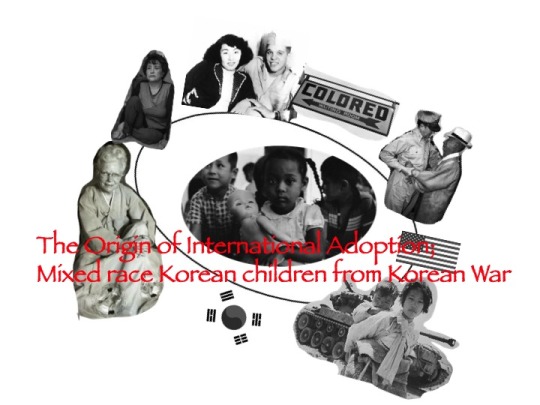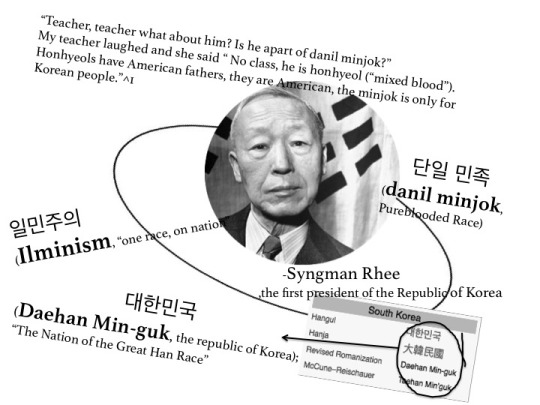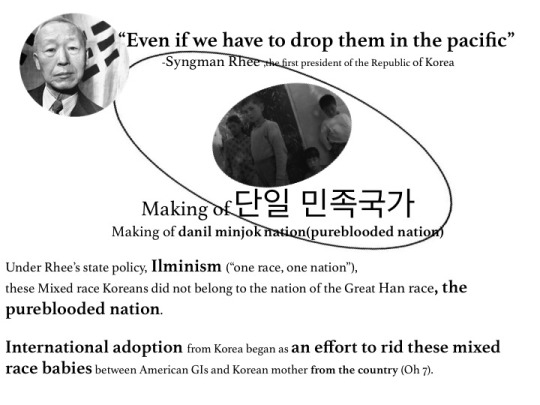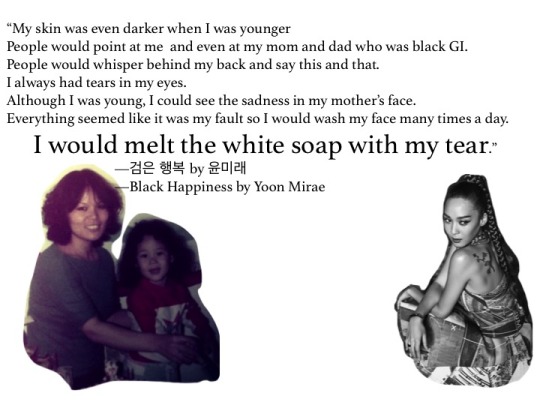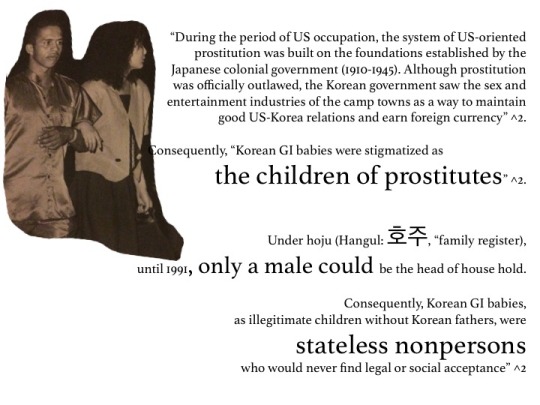Text
Final Zine link
https://issuu.com/daeleehan/docs/zine_final_pdf
0 notes
Text
Zine cover, sample page
Name: Daehui Han Section time: Mon 4:00-4:50pm TA Instructor: David Sanchez-Aguilera
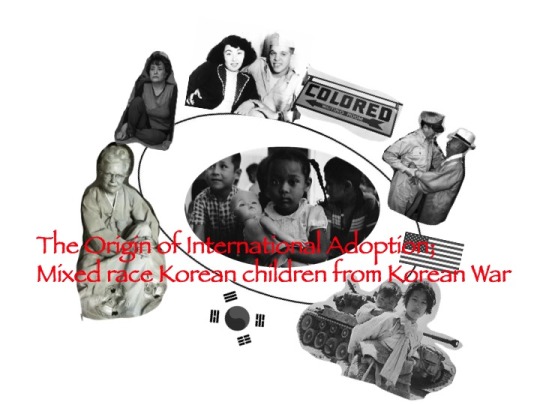

0 notes
Text
Notebook 3
Name: Daehui Han Section time: Mon 4:00-4:50pm TA Instructor: David Sanchez-Aguilera
1. Relational Analysis
Anti-blakckness Whiteness Citizenship Immigration The USA
Institutionalized anti-blackness made it more likely for the mixed race Korean children to be abandoned by their American father. Korean mother and the American GI father would be subject to anti miscegenation laws in some US states. Moreover, due to anti-Asian immigration laws until 1952, the American GIs could not bring the Korean mothers back to their country, even if they wanted to. Arissa Oh reports that commanding officers in the US military bases in Korea would refuse to give the GIs permission to marry, and even went so far as to separate a couple by transferring the man elsewhere (Oh 6).
On the other hand, Americans preferred adopting a nonwhite children from oversea, which the vast majority was in Asia by that time, to a nonwhite American child.
This popularity of adopting Korean children attribute to “orientalist constructions that emphasized Korean children’s racial difference in nonthreatening ways” as well as the fact that they represented “a digestible diversity that Americans prized in the midst of a new emphasis on multiculturalism and colorblindness after the civil rights movement”. This representation emphasized their “not-blackness”(12). Moreover, as the cases such as Russel Green from the previous notebook indicates, when they no longer represented “not-blackness”, they were subject to deportation.
This shows that by the imagined proximity of the mixed race Korean children to blackness and whiteness determined whether or not they were desired and allowed in the USA.
Militarism
The US military and the country sought to justify, mitigate, and positively project its role in Korea and in the new world of the Cold War. GI’s child welfare efforts served this political function. GI humanitarianism as a result, wordlessly refuted charges of US imperialism while modeling for Americans at home the ways in which individuals could participate in fostering international goodwill (46).
Religion
As mentioned in the notebook 1, Christian missionaries and social workers in Korea played an important role in organizing and systematizing the practice of international adoption (Oh 3). The adoption of a Korean GI babies offered Christians and Christian Americanists alike a mean by which to enact their beliefs. For devout Christians like Harry Holt, adopting a GI baby was missionary work through which they could bear witness to their faith and serve God (110). For Christian Americanists, there adoptions were a way for patriotic Cold War Americans to participate in their country’s international Christianizing and Americanizing mission (110).
sources:
1. To Save the Children of Korea(Arissah Oh) http://www.sup.org/books/title/?id=24463
2. Russel David Green case http://www.halfkorean.com/?p=6867
0 notes
Text
Notebook 2
Name: Daehui Han Section time: Mon 4:00-4:50pm TA Instructor: David Sanchez-Aguilera
Object:
Korean adoptees in the 1950’s —> the Korean mixed race children depicted in the Joo Myung Duck’s work that were taken in Harry Holt Memorial Orphanage in Ilsan, Korea
I made this change to talk about the circulation of mixed race Korean children. Korean adoption started in order to expel mixed race Korean babies. As mentioned in the Notebook 1, the high increase in the number of mixed race Korean babies were the result of the presence of US military, and the sex industry that formed near the US military bases. In addition, American christian missionaries and social workers that include Harry Holt, a lumberman and farmer from Oregon, played a critical role in making the practice of international adoption systematic in South Korea (8 Oh). Therefore, by telling the story about the mixed race orphan at an American humanitarian organization established on a Christian foundation, I will discuss how the intersections of race, gender and religion circulate and change over time.
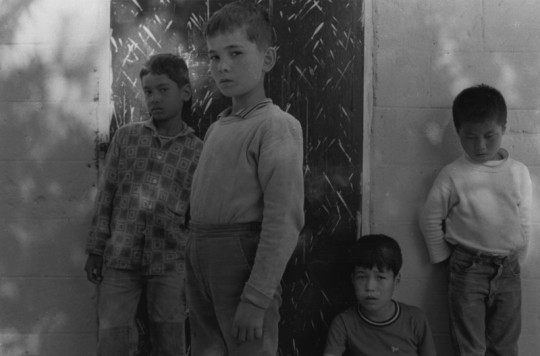
Biracial orphans of the Korean War, 1960s. Joo Myung Duck
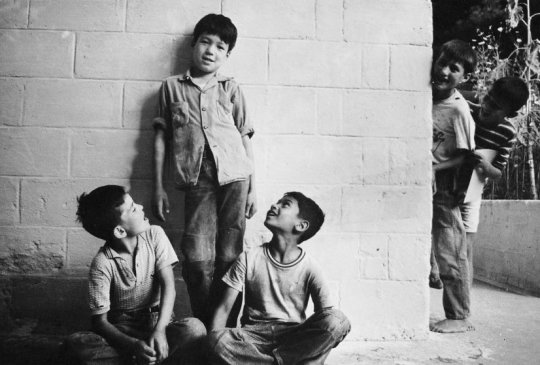
Biracial orphans of the Korean War, 1960s. Joo Myung Duck
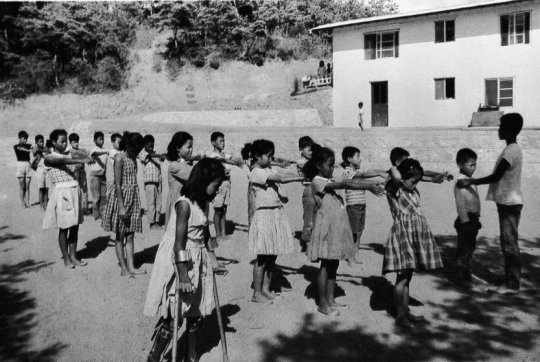
Biracial orphans of the Korean War, 1960s. Joo Myung Duck
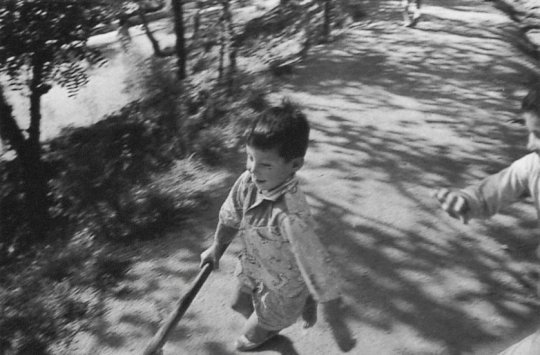
Biracial orphans of the Korean War, 1960s. Joo Myung Duck
Theme:
(Im)migration and Citizenship
“under Korean law, citizenship passed from father to child; as illegitimate children without Korean fathers, GI babies were stateless nonpersons who would never find legal or social acceptance” (7). “Even if these children were born from consensual romantic relationships, or the American father wanted to bring his baby and the mother to the United States, “the highly restrictive immigration regime of the United States contained no provisions for the entry of adopted foreign children, fiancées, or spouses, leaving them subject to the country-specific quotas and race-based exclusion instituted by the 1924 Immigration Act” (5). As a result, Korean mothers were left unmarried with a stateless mixed race child. However, Congress amended US immigration law in 1961 to make international adoption permanently possible when the interests of the South Korean government to expel mixed race children, and the demand of children by white American families were met in addition to the effort of Christian Americanists (8).
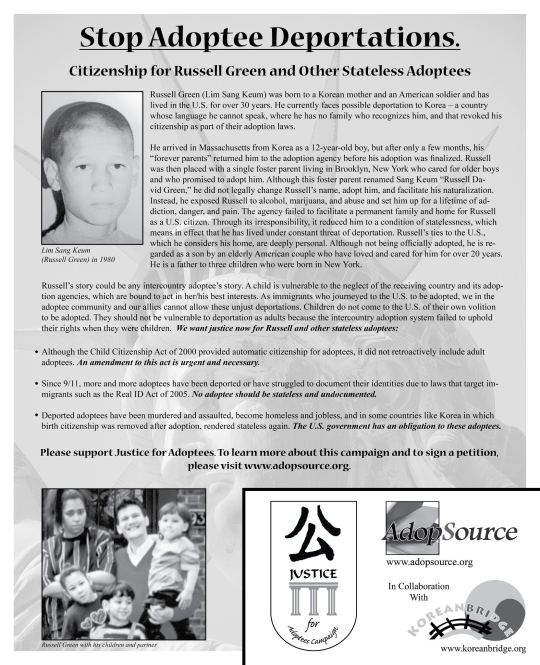
Russell David Green, Image courtesy of AdopSource / Korean Bridge
Despite the fact that the adoptees were sent to the United States for an adoption, there are cases that the United States government deports the adoptees back from the country of their origin, where they no longer hold any memory of. This is for example Russell David Green (Lee Sang Keum). Russel David Green is an Korean mixed race adoptee who were sent to the U.S at the age of 12. His adoptive family returned him to the adoption agency before his adoption was finalized. He was then sent to a foster family who never adopted him nor facilitated his naturalization. Russell then suffered from abuse by his foster family. Russell is not deported to the South Korea.
By examining the circulation through the importation and deportation of mixed race children, I would like to discuss this circulation of Korean adoptees with the theme of citizenship and immigration.
Trans/national contexts:
Korea and the USA
National binds:
South Korea
Colonialism
The United States officially occupied southern half of Korea after the World War 2 (1945). This led to a separate government in the South apart from the northern half of Korea, which is what is now known as South Korea (Republic of Korea). Although the official occupation lasted for only for three years (1945-1948), a neocolonial nature is clearly observed in the relationship between South Korea and the United States, as indicated by the current US military presence and cultural, political, and economic influence.
Militarism and War
The US military government occupied the southern half of Korea after World War 2. This led northern half of Korea to bring down their troops to the south, which became what is now known as the Korea War. Even after the war was temporally paused in the 1953, the military tension between two parts of Korea became the excuse for the military dictatorships, the US military presence, and the neocolonial relationship between the South Korea and the United States.
Sexual exploitation
“During the period of US occupation, the system of US-oriented prostitution was built on the foundations established by the Japanese colonial government (1910-1945). Although prostitution was officially outlawed, the Korean government saw the sex and entertainment industries of the camp towns as a way to maintain good US-Korea relations and earn foreign currency” (Oh 49).
“According to a Eighth US Army(EUSA) intelligence officer, the American troops in Korea contributed 25% of South Korea’s GNP in the 1960s. In 1987, the U.S. forces contributed an estimated $1 billion to the South Korean economy, or about 1% of the total GNP. The EUSA Inspector General in 1964 highlighted the importance of prostitution on the local camptown economy: “At the local community level the business of prostitution is recognized as a source of income large enough to have an impact on the economy”. Similarly, in the spring of 1992, a Korean Protestant minister who serves the prostitute community in Songt’an commented that prostitution and related businesses supported 60% of Songt’an’s economy” (Moon sex among allies 44).
This US camptown prostitution industry is still present in South Korea. In other words, sexual exploitation of Korean women’s bodies were used as the foundation and building blocks of current Korean government.
USA
Colonialism Whiteness Citizenship Exploitation Genocide
Intersectional analysis:
religion whiteness heteronormativity gender race citizenship
Although international adoption started after World War 2 when Americans adopted children from various European countries and Japan, it was not until after Korean War (1950-1953), when Korean adoption began that international adoption became systematical and organized (Oh 3). A partial answer to the question of why Korean adoption took off while other forms of international adoption in German and Japan did not is because only Korean adoption had a leader like Harry Holt (8). Harry Holt established an adoption program in 1956, which is when significant numbers of overseas placements occurred (8). Harry Holt took on the adoption of Korea GI babies as a kind of missionary work, a way for Americans to participate in their country’s Cold War project of proving its racial liberalism and wining the allegiance of newly independent countries around the world (8). Author of the book, To Save the Children of Korea call this powerful religious and patriotic ideology Christian Americanism, and explains that this drove the changes to US immigration laws that opened the way for large-scale emigration and adoption of Korean children (8). In response to Christian Americanist efforts, Congress amended US immigration law in 1961 to make international adoption permanently possible (8).
In addition, as mentioned in the Notebook 1, a rise in prostitution and the birth of illegitimate mixed race children were resulted from the presence of US military troop presence. This was under the assumption that American GIs are heterosexual, and female bodies are necessary for heterosexual males’s comfort, both the US military and the South Korean government maintained and managed prostitution industry near the US military bases.
Moreover, I would like to discuss the gendered relationship between Korea and the United States. The idea that Koreans need Americans to protect from their own, to colonize and to rape puts Korea in a feminized role and America is a masculine role. In this project, I would like to examine how this gendered assumption of the two countries played apart in building a camp town prostitution industry, which resulted in the mixed race children, and in establishing mass baby importing system as a humanitarian action.
sources: 1. Joo Myung Duck photography http://time.com/3605816/joo-myung-duck-portraits-of-mixed-race-orphans-in-postwar-korea/
2. Sex Among Allies (Katharine H.S. Moon) https://cup.columbia.edu/book/sex-among-allies/9780231106436
3. To Save the Children of Korea(Arissah Oh) http://www.sup.org/books/title/?id=24463
4. Adam Crapser case http://www.npr.org/sections/thetwo-way/2016/11/17/502413247/as-adoptee-in-u-s-awaits-deportation-his-korean-birth-mother-is-studying-english
5. Russel David Green case http://www.halfkorean.com/?p=6867
1 note
·
View note
Text
Notebook 1
Name: Daehui Han
Section time: Mon 4:00-4:50pm
TA Instructor: David Sanchez-Aguilera
Object: Korean adoptees in the 1950’s
Theme: (Im)migration and Citizenship
Description of my object:
The practice of adoption has existed since ancient times. However, international adoption –the adoption of children from abroad—is a recent and new phenomenon. This modern adoption is unique also in its association with humanitarianism, infertility and especially in its systemic, careful and complete invisibility of natal kinship^1.
Although international adoption started after World War 2 when Americans adopted children from various European countries and Japan, it was not until after Korean War (1950-1953), when Korean adoption began that international adoption became systematical and organized, which in result making this practice a significant phenomenon in the United States (Oh 3).
Korean children account for the vast majority of American international adoptions. Korea was the number one sending country of children to the United States until 1995, and Americans adopted approximately two thirds of the 150,000 children that Korea sent overseas for adoption between the Korean War and the end of the century (3).
Trans/national contexts:
“Even if we have to drop them in the pacific” – President Syngman Rhee
International adoption from Korea began as an effort to rid mixed race babies between American GIs and Korean mother from the country (7). Historians that include Yukiko Koshiro, Maria Hohn and Seungsook Moon have noted the correspondence between foreign troop presence and a rise in prostitution and the birth of illegitimate children. These have also been major features of the US presence in Korea since the end of the World War 2 (49). Consequently, “Korean GI babies were stigmatized as the children of prostitutes” (7).
Moreover, “Koreans and Americans alike argued for the removal of GI babies on the assumption that their racial mixture and physical difference would make it impossible for them to fit into Korean society, which conceived of itself as racially homogeneous. Korean ethnic nationalism based on a belief in a common prehistoric origin and bloodline had existed since before the Korean War” (52).
In addition, “under Korean law, citizenship passed from father to child; as illegitimate children without Korean fathers, GI babies were stateless nonpersons who would never find legal or social acceptance” (7). “Even if these children were born from consensual romantic relationships, or the American father wanted to bring his baby and the mother to the United States, “the highly restrictive immigration regime of the United States contained no provisions for the entry of adopted foreign children, fiancées, or spouses, leaving them subject to the country-specific quotas and race-based exclusion instituted by the 1924 Immigration Act” (5). As a result, Korean mothers were left unmarried with a stateless mixed race child.
In the meantime, “the demand for healthy white infants – the children adopters most wanted—had exceeded the number available since 1920s.” “Formal adoption did not begin until after World War 2, but the search for healthy white babies propelled Americans across borders before the 1940”. “Americans acquired children from Canada and Mexico through gray markets”(4). “In other words, although the Korean government wished to remove GI babies, and Americans wanted to adopt them.” (8)
Sources:
1.
1http://pages.uoregon.edu/adoption/topics/adoptionhistbrief.htm
2.
To Save The Children of Korea by Oh, Arissa
(http://www.sup.org/books/title/?id=24463)
1 note
·
View note
